

The Battle of the Somme. Advance to Victory. Western Front 1918: The German Offensives. The Ypres Salient. First World War: Trench Warfare. The failure of the Schlieffen Plan. Illustrated trench scen. The National Archives. WORLD WAR ONE TRENCH WARFARE. The Battle of Verdun.
In the trenches of 1914-1918. World War One. World War One An A to Z of World War One Timeline of World War One 1914 and World War One.

BBC iWonder - How did so many soldiers survive the trenches? First World War.com - A Multimedia History of World War One. Trench Warfare Video - World War I History. BBC Schools - Life in the trenches. 31 October 2014Last updated at 15:07 Two British soldiers standing in a flooded communication trench during World War One On the Western Front, the war was fought in trenches. Trenches were long, narrow ditches dug into the ground where soldiers lived all day and night. There were many lines of German trenches on one side and many lines of Allied trenches on the other. In the middle, was no man's land, so-called because it did not belong to either army. Rest. Two soldiers in flooded trenc. Life In The Trenches. There was nothing glamorous about trench life.
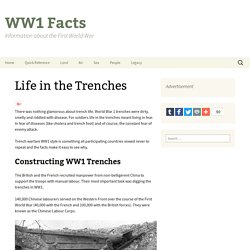
World War 1 trenches were dirty, smelly and riddled with disease. For soldiers life in the trenches meant living in fear. In fear of diseases (like cholera and trench foot) and of course, the constant fear of enemy attack. Trench warfare WW1 style is something all participating countries vowed never to repeat and the facts make it easy to see why. Constructing WW1 Trenches. World War I: One Word Video - World War I History. Trench Warfare Prior to World War 1 - Trench Warfare.
The Western Front Association: dedicated to the study of The Great War 1914-18. explore. Mud Blood and Poppycock. The 'Horrors' of the Trenches Source L: The Perception: Mud, Blood and Poppycock, page 76 The perception of soldiering in the Great War is of a young patriot enlisting in 1914 to do his bit, and then being shipped off to France.
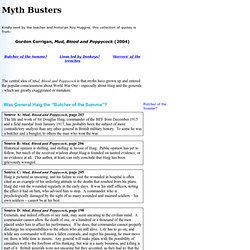
Arriving at one of the Channel ports he marches all the way up to the front, singing ‘Tipperary’ and smoking his pipe, forage cap on the back of his head. Reaching the firing line, he is put into a filthy hole in the ground and stays there until 1918. If he survives, he is fed a tasteless and meagre diet of bully beef and biscuits. Source M: Marching: Mud, Blood and Poppycock, page 76 The original BEF, composed of pre-war regulars and reservists, did do quite a lot of marching, but they would have been very unlucky to have to tramp all the way from Boulogne to Belgium.
Source N: Trenches: Mud, Blood and Poppycock, page 79. British military crime and punishment of 1914-1918. Military law reinforces discipline The maintenance of discipline in the army has always been considered a very serious affair.
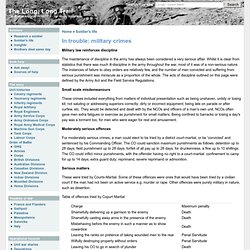
Whilst it is clear from statistics that there was much ill-discipline in the army throughout the war, most of it was of a non-serious nature. The instances of failure to obey orders are relatively few, and the number of men convicted and suffering from serious punishment was miniscule as a proportion of the whole. The acts of discipline outlined on this page were defined by the Army Act and the Field Service Regulations.
Small scale misdemeanours These crimes included everything from matters of individual presentation such as being unshaven, untidy or losing kit; not saluting or addressing superiors correctly; dirty or incorrect equipment; being late on parade or after curfew, etc. Moderately serious offences For moderately serious crimes, a man could elect to be tried by a district court-martial, or be 'convicted' and sentenced by his Commanding Officer. World War One executions. Content In World War One, the executions of 306 British and Commonwealth soldiers took place.
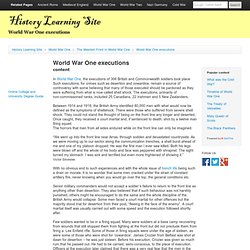
Such executions, for crimes such as desertion and cowardice, remain a source of controversy with some believing that many of those executed should be pardoned as they were suffering from what is now called shell shock. The executions, primarily of non-commissioned ranks, included 25 Canadians, 22 Irishmen and 5 New Zealanders. Between 1914 and 1918, the British Army identified 80,000 men with what would now be defined as the symptoms of shellshock. There were those who suffered from severe shell shock. The medical treatment of British casualties in 1914-1918.
This page describes the main medical functions in a complex chain that processed the casualty from the front line back to hospitals at home.

It is in a simplified format. Many men missed stages altogether, and of course many wounded soldiers were in no condition to know which of these units was caring for them. Aid and Bearer Relay Posts The casualty is likely to have received first medical attention at aid posts situated in or close behind the front line position.
Units in the trenches provided such posts and generally had a Medical Officer, orderlies and men trained as stretcher bearers who would provide this support. History - World Wars: Battle of Passchendaele: 31 July - 6 November 1917. Advance to Victory. Battles - The Battle of the Somme, 1916. Comprising the main Allied attack on the Western Front during 1916, the Battle of the Somme is famous chiefly on account of the loss of 58,000 British troops (one third of them killed) on the first day of the battle, 1 July 1916, which to this day remains a one-day record.
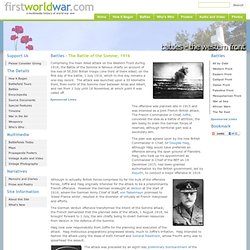
The attack was launched upon a 30 kilometre front, from north of the Somme river between Arras and Albert, and ran from 1 July until 18 November, at which point it was called off. The offensive was planned late in 1915 and was intended as a joint French-British attack. The French Commander in Chief, Joffre, conceived the idea as a battle of attrition, the aim being to drain the German forces of reserves, although territorial gain was a secondary aim. The Somme - From Defeat To Victory - Part 1. Sir Douglas Haig's Somme Despatch. The second Despatch of Field Marshal Sir Douglas Haig, Commander in Chief of the British Armies in France and Flanders.
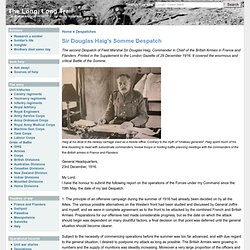
The Somme - From Defeat To Victory - Part 2. The Somme - From Defeat To Victory - Part 5. In the trenches of 1914-1918. The Western Front in France and Flanders in 1914-1918. This section of the Long, Long Trail will be helpful for anyone wishing to find out about the fighting in France and Flanders.

What was the Western Front? The Western Front was the name applied to the fighting zone in France and Flanders, where the British, French, Belgian and (towards the end of the war) the American armies faced that of Germany. There was an Eastern Front too, in Poland, Galicia and down to Serbia, where Russian armies faced those of Germany and Austria-Hungary. The Military Service Act 1916. The Military Service Act of 27 January 1916 brought conscription into effect for the first time in the war.
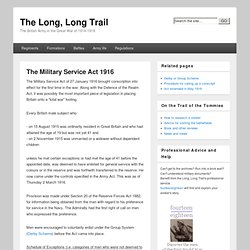
Along with the Defence of the Realm Act, it was possibly the most important piece of legislation in placing Britain onto a "total war" footing. Every British male subject who - on 15 August 1915 was ordinarily resident in Great Britain and who had attained the age of 19 but was not yet 41 and - on 2 November 1915 was unmarried or a widower without dependent children. Podcast 3: Joining up. IMPERIAL WAR MUSEUM’s Voices of the First World War Here is the third in a series of podcasts that delve into IWM’s sound collection to bring you the voices of those who lived through the First World War.
Find out what a huge range of people felt, experienced and witnessed between 1914-1918 – and the impact the events of those years had on their lives. Hear from a range of people as they describe how and why men enlisted following the outbreak of war. Podcast 3: Joining up Download mp3 (15Mb) Transcript Suddenly everybody’s sons and brothers and husbands were soldiers. The iconic Kitchener recruitment poster that Irving Jones couldn’t avoid. British Army enlistment 1914-1918. The expansion of the British Army from the small professional force to a vast citizen army, capable of defeating the world's most formidable military machine, was a truly extraordinary national achievement.
How was it done? What does this tell you about the way your soldier joined up? Types of service available: up to the declaration of war Since 1908 the British Army had offered four forms of recruitment. Why did Britain go to war? Podcasts. Blackadder on the Causes of World War One. The following famous scene from Blackadder Goes Forth: Goodbyee deals with the causes of the war. The humour is quite subtle, and you need to know about the Causes of World War One to fully appreciate why it is so funny. In the episode, Blackadder is feigning madness to try to avoid going over the top.
While they are waiting, Baldrick asks permission to ask a question... Baldrick: The thing is: The way I see it, these days there's a war on, right? And, ages ago, there wasn't a war on, right? Edmund: Do you mean "Why did the war start? " Baldrick: Yeah.